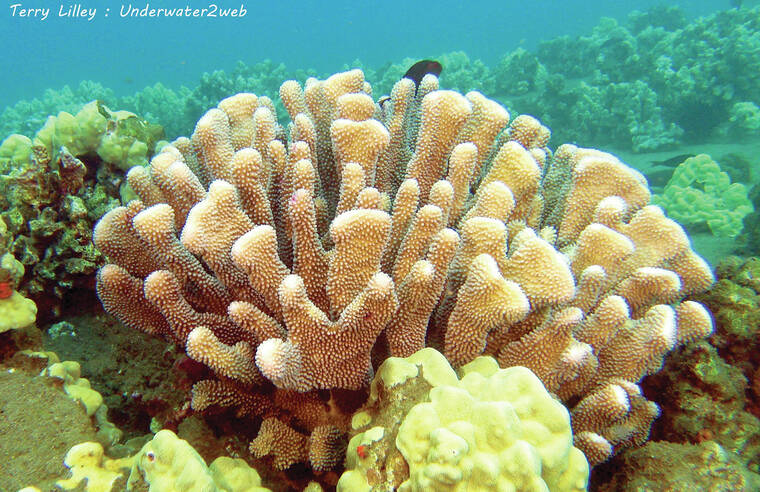CRITTER: Endangered unique coral reef at Mala Wharf in West Maui
There is a very unique coral reef in Lahaina, Hawai‘i, that was started by hurricane Iniki back in 1992 when huge 30-foot waves tore apart a pier that was used by the pineapple industry.
The huge concrete pilings of the pier were broken up and piled on the seafloor in 30 feet of water. The pilings and top of the pier fell down on the sandy bottom and created a unique artificial reef that is laced with overhangs and caves that make perfect habitat for marine life.
What is so interesting about Mala Wharf for us marine biologists is we know the exact date the pier went down, so we also know the exact date that corals started to grow on the underwater concrete columns. This allows us to look at the corals today and know how old some of them are, which is very hard to do on a natural rocky reef that may have had coral growth on it over 1,000 years ago.
What is also very unique about Mala Wharf is the pier fell down on sand, so it is the only reef structure in the area for marine life to hide in. This isolated concrete reef is now a gold mine for marine life studies because it has a cross section of marine life that lives in Maui and is basically an entire marine life city. On land it would be similar to a green oasis and spring in the middle of a dry hot desert.
On a one-hour long scuba dive last summer, I shot video of 12 breeding white tip reef sharks at Mala Wharf along with 14 large green sea turtles that were getting their shells cleaned by small fish. I also shot video of eight different butterfly fish species, five large blue finned trevally, puffer fish, huge school of chubs and over 1,000 goatfish.
Under the pier rubble in the caves I saw red squirrelfish, colorful nudibranchs, orange cup corals, snowflake corals and even a black coral. On the top of the artificial reef were thousands of corals and some were over 3 feet tall. If you dive Mala Reef often you will see most of the marine life species in one location that you would find in 30 different Maui dive sites.
We all have watched the horrifying fires in Lahaina over the past week and I know people personally there that lost their homes and loved ones. The images on TV are hard to watch, but the fire damage is not over as it will affect Maui marine life for years to come.
Many of the Lahaina buildings were built many years ago when they used lead paint and toxic chemicals in the plywood, carpet and wallpaper. They used asbestos in the walls for insulation and heavy metals in the appliances. The metal in the building structure and vehicles is toxic to a coral reef. Iron released into the sea from buildings and sunken boats causes coral disease outbreaks. Mud, debris and toxic ash can coat the corals so they cannot get the sunlight they need to photosynthesise and produce food.
Within about 90 days we will be able to see the effects of the fire on the marine life at Mala Wharf, and I just hope the damage is not too bad because it took a hurricane to form this unique Maui coral reef. Lets hope it lives through the worst fire a coral reef will ever see.
Midway through last summer, I shot a video of marine life at Mala Wharf right in the middle of the shark breeding season. Here is the link to the video. https://tgilinks.com/3qD9Yha. In 90 days from now, I will go back and do a similar video so we can track the damage caused by the fire and see if the marine life survived.
•••
Terry Lilley is a marine biologist living in Hanalei Kaua‘i and co-founder of Reef Guardians Hawai‘i, a nonprofit on a mission to provide education and resources to protect the coral reef. To donate to Reef Guardians Hawaii go to www.reefguardianshawaii.org.




